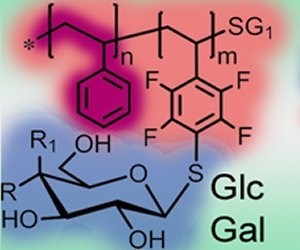Home > Press > A New Playground for Particle Design
 |
| Researchers from the University of Jena (Germany) designed glycopolymeric materials with tailored properties to independently study the parameters that impact cellular uptake. |
Abstract:
Synthetic polymers offer the possibility to introduce biologically active moieties and to design tailor-made macromolecules with well-defined architectures and properties. The design of glycopolymeric materials with tailored properties has become a very important topic of interest in current chemistry, biology, and medicine.
A New Playground for Particle Design
Germany | Posted on August 10th, 2012The main reason behind this significance lies within their structure. A glycopolymer, by definition, consists of a synthetic polymeric backbone with covalently-linked, pendant carbohydrate moieties. The backbone may be composed of various monomeric units, in different arrangements. As a consequence, it provides the possibility to adjust the physical properties, such as water solubility of the final material.
The second building block of a glycopolymer consists of pendant sugar moieties which act as ligands for a broad spectrum of protein receptors that play an important role in different cell-surface interactions. Therefore, the structure of synthetic glycopolymers allows the precise modification of their material and biological features for special biomedical purposes.
Now, the research group around Ulrich Schubert (University of Jena) have demonstrated that poly(pentafluorostyrene)-based glycopolymers also possess the above-mentioned properties. By the introduction of hydrophobic polystyrene block into the backbone they can modify the water solubility of the system and obtain amphiphilic glycopolymers. These materials do not dissolve in aqueous environments. Under appropriate conditions they form nanoparticles with carbohydrates on the surface. By the introduction of glucose or galactose the recognition and uptake of these polymers by liver cancer cells is modified.
Fluorescence microscopy and flow cytometry show that nanoparticles are taken up by these cells to a higher degree than respective water soluble polymers, and that internalization of galactosylated materials is enhanced. These glycopolymers can find a multitude of potential applications in, for example, liver tumor-targeted chemotherapy, imaging, and as extracellular matrices for hepatocytes.
####
For more information, please click here
Copyright © Wiley-VCH Materials Science Journals
If you have a comment, please Contact us.Issuers of news releases, not 7th Wave, Inc. or Nanotechnology Now, are solely responsible for the accuracy of the content.
| Related Links |
![]() Link to the original paper on Wiley Online Library:
Link to the original paper on Wiley Online Library:
| Related News Press |
News and information
![]() Simulating magnetization in a Heisenberg quantum spin chain April 5th, 2024
Simulating magnetization in a Heisenberg quantum spin chain April 5th, 2024
![]() NRL charters Navy’s quantum inertial navigation path to reduce drift April 5th, 2024
NRL charters Navy’s quantum inertial navigation path to reduce drift April 5th, 2024
![]() Discovery points path to flash-like memory for storing qubits: Rice find could hasten development of nonvolatile quantum memory April 5th, 2024
Discovery points path to flash-like memory for storing qubits: Rice find could hasten development of nonvolatile quantum memory April 5th, 2024
Chemistry
![]() What heat can tell us about battery chemistry: using the Peltier effect to study lithium-ion cells March 8th, 2024
What heat can tell us about battery chemistry: using the Peltier effect to study lithium-ion cells March 8th, 2024
![]() Nanoscale CL thermometry with lanthanide-doped heavy-metal oxide in TEM March 8th, 2024
Nanoscale CL thermometry with lanthanide-doped heavy-metal oxide in TEM March 8th, 2024
Nanomedicine
![]() New micromaterial releases nanoparticles that selectively destroy cancer cells April 5th, 2024
New micromaterial releases nanoparticles that selectively destroy cancer cells April 5th, 2024
![]() Good as gold - improving infectious disease testing with gold nanoparticles April 5th, 2024
Good as gold - improving infectious disease testing with gold nanoparticles April 5th, 2024
![]() Researchers develop artificial building blocks of life March 8th, 2024
Researchers develop artificial building blocks of life March 8th, 2024
Discoveries
![]() Chemical reactions can scramble quantum information as well as black holes April 5th, 2024
Chemical reactions can scramble quantum information as well as black holes April 5th, 2024
![]() New micromaterial releases nanoparticles that selectively destroy cancer cells April 5th, 2024
New micromaterial releases nanoparticles that selectively destroy cancer cells April 5th, 2024
![]() Utilizing palladium for addressing contact issues of buried oxide thin film transistors April 5th, 2024
Utilizing palladium for addressing contact issues of buried oxide thin film transistors April 5th, 2024
Announcements
![]() NRL charters Navy’s quantum inertial navigation path to reduce drift April 5th, 2024
NRL charters Navy’s quantum inertial navigation path to reduce drift April 5th, 2024
![]() Discovery points path to flash-like memory for storing qubits: Rice find could hasten development of nonvolatile quantum memory April 5th, 2024
Discovery points path to flash-like memory for storing qubits: Rice find could hasten development of nonvolatile quantum memory April 5th, 2024
Nanobiotechnology
![]() New micromaterial releases nanoparticles that selectively destroy cancer cells April 5th, 2024
New micromaterial releases nanoparticles that selectively destroy cancer cells April 5th, 2024
![]() Good as gold - improving infectious disease testing with gold nanoparticles April 5th, 2024
Good as gold - improving infectious disease testing with gold nanoparticles April 5th, 2024
![]() Researchers develop artificial building blocks of life March 8th, 2024
Researchers develop artificial building blocks of life March 8th, 2024
|
|
||
|
|
||
| The latest news from around the world, FREE | ||
|
|
||
|
|
||
| Premium Products | ||
|
|
||
|
Only the news you want to read!
Learn More |
||
|
|
||
|
Full-service, expert consulting
Learn More |
||
|
|
||








